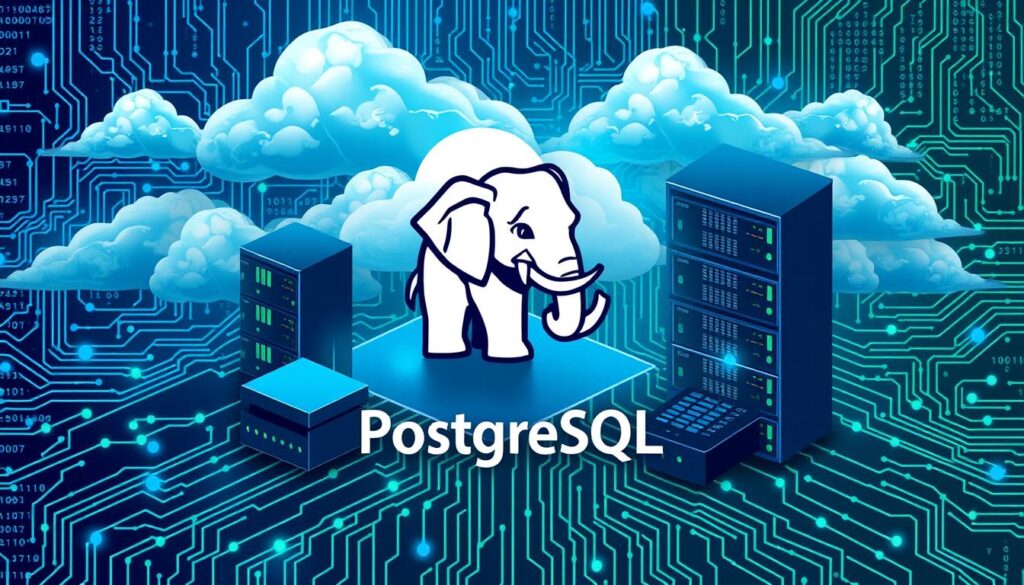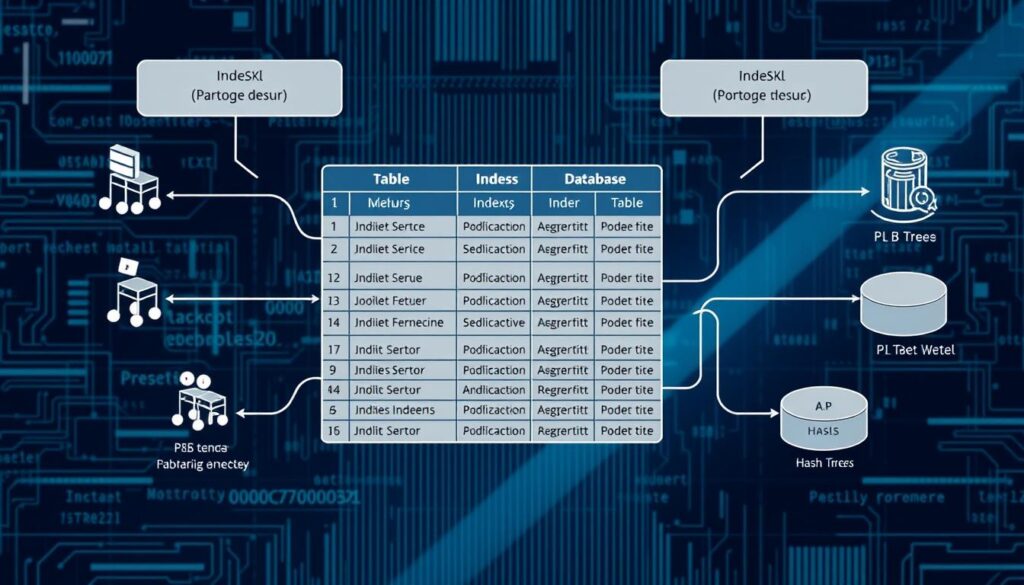
Did you know PostgreSQL has been around for over 35 years? It meets 170 out of 177 SQL:2023 Core features as of version 16 in September 2023. This long history and strong feature set make it a top pick for many data-focused projects.
We’re here to clear up what *What is PostgreSQL* means. We’ll see why it’s a favorite among developers, data scientists, and big companies. It started at the University of California, Berkeley in 1986. Now, it supports advanced data types, strong data integrity, and top-notch security.
PostgreSQL is great for handling big data, supporting many users at once, and offering detailed security. Big names like Amazon, Heroku, and Simple Finance rely on it for their data. This shows how reliable and fast PostgreSQL is.
Key Takeaways
- PostgreSQL has over 35 years of continuous development.
- It conforms to most SQL:2023 standards, enhancing its reliability and performance.
- Supports a wide array of data types, including custom and geospatial with PostGIS.
- Offers robust data integrity and concurrency mechanisms.
- Trusted by major enterprises like Amazon and Heroku.
Introduction to PostgreSQL
PostgreSQL started in 1982 by Michael Stonebraker at the University of California, Berkeley. It has become a top database system. Michael Stonebraker won the Turing Award in 2014 for his work on PostgreSQL. We will explore its history, architecture, and open source community.
History and Evolution
The POSTGRES project began in 1986. By 1994, it added SQL support, making it more powerful. It works on UNIX-like platforms, Mac OS X, Solaris, and Windows.
Postgres95 was released in 1994. It replaced PostQUEL with SQL and improved performance. PostgreSQL has grown for over 20 years, thanks to an open-source community.
It now has features like user-defined types and multi-version concurrency control. Each update shows PostgreSQL’s focus on scalability and performance. This makes it a strong choice against MySQL.
Core Architecture
PostgreSQL is an object-relational database system. It supports advanced data types and object-oriented programming. It uses a client-server model for reliable data access.
It has features like complex SQL queries and full-text search. PostgreSQL can handle relational and non-relational data. This makes it great for many applications.
Open Source Community
PostgreSQL is open-source, with a strong community. The source code is under the PostgreSQL license. This encourages collaborative development.
Companies like Apple and Red Hat use PostgreSQL. The community keeps improving it. This ensures PostgreSQL stays at the top of database technology.
In summary, PostgreSQL’s history, architecture, and community make it a versatile database system. Its evolution shows its dedication to meeting various application needs.
Key Features of PostgreSQL
PostgreSQL is known for its powerful features. It’s a top choice for database management. Let’s explore what makes it stand out.
Data Types
PostgreSQL supports many data types. It goes beyond basic types like integers and strings. It also handles complex types like arrays and JSON/JSONB.
It even supports geographic data with PostGIS. This makes it great for GIS and location-based services.
Data Integrity and Concurrency
PostgreSQL focuses on data integrity. It uses constraints and compliance features to keep data safe. It also has advanced indexing for better data retrieval.
It handles multiple transactions well. This is thanks to Multi-Version Concurrency Control (MVCC). It keeps applications running smoothly, even with a lot of traffic.
Extensibility and Customization
PostgreSQL is highly extensible. Users can create custom data types and functions. They can even write code in languages like PL/pgSQL and PL/Python.
It also works well with DevOps and cloud environments. This makes it great for continuous integration and delivery. It ensures smooth deployment and high availability.
These features make PostgreSQL a top choice. It’s perfect for web, mobile, data warehousing, and business intelligence tasks.
Benefits of Using PostgreSQL
Choosing a database system can be tough. PostgreSQL shines for many reasons. Let’s dive into what makes it a top choice.
Performance and Scalability
PostgreSQL is known for its top-notch performance and ability to grow. It handles big data well. Its bulk data operations and support for many indexing methods make it efficient.
- It supports various replication methods for high availability and data integrity.
- PostgreSQL updates regularly, fixing bugs and meeting user needs.
Its scalability is unmatched, making it great for all sizes of applications.
Security
PostgreSQL focuses on security. It uses strong authentication and access controls. This keeps data safe and private.
It also supports SSL encryption for secure network communication. This makes PostgreSQL a top pick for sensitive data.
Reliability and Disaster Recovery
PostgreSQL is reliable and excels in disaster recovery. It uses write-ahead logging and replication for data consistency. Its Point-In-Time-Recovery feature adds extra reliability.
Here’s a quick look at PostgreSQL’s disaster recovery features:
| Feature | Description |
|---|---|
| Write-Ahead Logging (WAL) | Ensures data integrity by logging all changes. |
| Replication Methods | Supports asynchronous and synchronous replication for high availability. |
| Point-In-Time Recovery (PITR) | Allows restoring the database to a specific time, improving reliability. |
With its long history and robust features, PostgreSQL is perfect for critical systems.
Want to learn more about PostgreSQL? Check out more benefits here. If you’re thinking about installing PostgreSQL, it’s a powerful tool for managing data.
What is PostgreSQL
PostgreSQL is a powerful open-source database system. It combines the strengths of traditional databases with the flexibility of object-oriented systems. First released on July 8, 1996, it has grown to support many industries and applications. The latest version, 17.0, was released on September 26, 2024, showing its ongoing maturity.
PostgreSQL stands out for its ability to handle both relational (SQL) and non-relational (JSON) queries. This makes it useful for a wide range of tasks, from web apps to analytics. It also ensures data integrity with its ACID properties, even with many users accessing it at once.
It offers a wide range of features, including transactions, views, triggers, and stored procedures. PostgreSQL supports four transaction isolation levels and uses serializable snapshot isolation (SSI) for full serializability. It also has built-in replication options for data safety.
The PostgreSQL community has grown over 20 years. It’s known for its contributions and extensive documentation. Companies like Apple and Instagram rely on PostgreSQL, proving its reliability and flexibility.
PostgreSQL comes from the POSTGRES project at the University of California at Berkeley. It has always focused on open standards and innovation. Although there was a proposal to rename it to “Postgres,” the community chose to keep the name “PostgreSQL” to honor its history.
| Feature | Description |
|---|---|
| Transaction Isolation Levels | Read Uncommitted, Read Committed, Repeatable Read, Serializable |
| Replication | Asynchronous (WAL-based), Synchronous |
| Index Types | B-tree, Hash, GiST, GIN, SP-GiST, BRIN |
| Platform Support | Windows, Linux, macOS, FreeBSD, OpenBSD |
| Programming Language Support | Python, Java, C#, C/C++, Ruby, JavaScript (Node.js), Perl, Go, Tcl |
PostgreSQL is a key tool for developers and database experts. It offers a wide range of features and is highly customizable. Its reliability and scalability make it a top choice for businesses, thanks to the dedicated efforts of its community.
Installing and Setting Up PostgreSQL
Starting with PostgreSQL installation means knowing the system needs and following the steps. We’ll cover what’s needed for a strong PostgreSQL setup.
System Requirements
Your system must meet the minimum requirements for PostgreSQL. It works on Windows, macOS, and Linux like Debian and Ubuntu.
- Windows and macOS use port 5432 by default.
- For Debian and Ubuntu, update with:
sudo apt update. - Add the PostgreSQL repository with:
echo "deb http://apt.postgresql.org/pub/repos/apt/ $(. /etc/os-release; echo $VERSION_CODENAME)-pgdg main" | sudo tee /etc/apt/sources.list.d/pgdg.list.
Installation Steps
The installation steps are easy and well-documented. Here’s a quick guide:
- Update system packages:
sudo apt update- Install PostgreSQL:
sudo apt install postgresql postgresql-contrib- Start PostgreSQL service:
sudo systemctl start postgresql- Enable PostgreSQL at boot:
sudo systemctl enable postgresql- Check PostgreSQL status:
sudo systemctl status postgresql- Log in to PostgreSQL:
sudo -i -u postgrespsql- Create a new database:
CREATE DATABASE mydb;
Initial Configuration
After installation, configuring PostgreSQL is key for performance. Here are important steps:
- Change
postgresql.conffor settings likelisten_addressesandport. - Edit
pg_hba.conffor client authentication. - Reload the PostgreSQL service:
sudo systemctl reload postgresql
Customizing these settings boosts PostgreSQL performance for different needs.
PostgreSQL is great for SQL and JSON queries in many fields. It’s used in finance, healthcare, e-commerce, and more. These areas need strong data management and high transaction volumes.
Our setup helps industries use PostgreSQL fully. It’s a top choice for reliable, scalable databases. Its adoption rate grows about 10% each year, showing its growing importance.
Optimizing PostgreSQL Performance
Improving PostgreSQL performance is key to a fast database. We focus on good table design, smart indexing, and quick queries. This boosts our database’s power.
Table Design and Indexing
Optimizing table design and indexing is crucial. A well-organized schema makes data easy to find and use. Normalizing data removes duplicates and keeps it accurate.
Indexes also play a big role. They speed up queries, especially with big data. It’s vital for fast query times.
Improving performance also means looking at hardware. Use NVMe and SSD drives for faster data access. Also, keep WAL and data disks separate.
Query Optimization
Optimizing queries is about using PostgreSQL’s strengths. CTEs and understanding plans help queries run better. Partitioning large tables also improves query times.
For more tips on query tuning, check out the Sematext blog on PostgreSQL performance tuning.
Scaling Strategies
Scaling PostgreSQL is vital for growing data and users. Use multi-process and batch ingestion, keep materialized views, and use PgBouncer. These steps help scale your database.
Logical replication also supports high availability and upgrades. These strategies help your PostgreSQL database handle big data needs.
By covering all aspects of PostgreSQL performance, from hardware to scaling, we get a powerful database. It’s ready for growth and efficiency.
Conclusion
As we wrap up our look into PostgreSQL, it’s clear that this open-source database system has a lot to offer. It has a strong feature set and a lively community. This makes it a reliable and flexible choice for many projects.
PostgreSQL has grown a lot since 1996, thanks to its community and ongoing development. Big names like Netflix, Instagram, and Spotify use it for their data needs. It’s known for being reliable and fast.
PostgreSQL also supports JSON, foreign data wrappers, and follows ACID principles. This makes it great for handling complex and unstructured data. It’s a top choice for managing data, thanks to its many features.
In short, PostgreSQL is excellent for managing data. It can handle many transactions, has strong indexing, and is secure. With over 30 years of work, it’s a leading database system. We hope you now see the value of PostgreSQL in managing your data.
FAQ
What is PostgreSQL?
PostgreSQL is a powerful, open-source database system. It uses SQL to store and manage data. It also has object-oriented features like custom types and inheritance.
What are some key benefits of using PostgreSQL?
PostgreSQL is known for its high performance and scalability. It’s also very secure and reliable. It handles complex data operations well.
How do I install PostgreSQL?
First, check if your system meets the requirements. Then, follow the installation steps for your OS. There are guides and tutorials to help you.
What types of data can PostgreSQL handle?
PostgreSQL can handle many data types, like integers and strings. It also supports document and geometry types. You can even create custom types.
How does PostgreSQL ensure data integrity?
PostgreSQL uses unique constraints and foreign keys to ensure data integrity. It also supports all SQL transaction isolation levels. This keeps data consistent.
What are some strategies for optimizing PostgreSQL performance?
To improve performance, design tables and indexes carefully. Use query optimization techniques and scaling strategies. Practices like normalization and partitioning are key.
How does PostgreSQL handle security?
PostgreSQL has strong security features. It offers various authentication methods and access controls. Regular updates keep it secure against threats.
How does PostgreSQL support disaster recovery?
PostgreSQL uses write-ahead logging (WAL) and replication for disaster recovery. These ensure data integrity and availability, even during failures.
How does PostgreSQL compare to MySQL?
PostgreSQL and MySQL are both open-source databases. PostgreSQL has advanced features like custom data types. MySQL is known for its speed and ease of use. The choice depends on your project needs.
What is the role of the open-source community in PostgreSQL’s development?
The open-source community is vital for PostgreSQL’s growth. They provide enhancements, bug fixes, and new features. Their contributions keep PostgreSQL up-to-date and strong.
Future App Studios is an award-winning software development & outsourcing company. Our team of experts is ready to craft the solution your company needs.










